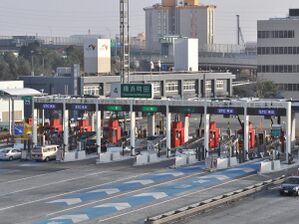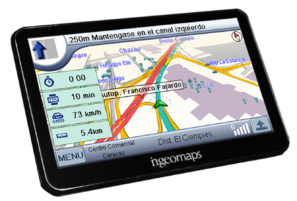Finance:Connected car commerce
Connected car commerce is a concept that combines a vehicle’s connectivity with a platform to engage in the purchase of goods and services while ‘on the go’[1]. Often, a graphical user interface via a smartphone or in-vehicle infotainment system enables riders to browse available retail options (e.g. fuel, food and beverage, parking, car wash, etc.) within a proximity of their current or desired location and offers suggested merchants or service providers.
Advanced systems allow users to make in-car payments, request an e-receipt, and specify delivery from the convenience of their car. In certain case, riders can complete a full transaction without actually leaving their vehicle. Alternative terms commonly used in the industry include 'in-car payment' or 'in-vehicle commerce'.
Historical context
The primary origins and pre-cursors of connected car commerce – e.g. the notion of engaging in commerce in-route to your destination – was introduced progressively with in-car navigation systems[2][3] and the adoption of smartphones[4][5] starting as early as the mid-2000’s.
Mobile GPS systems from the likes of Garmin, TomTom, and Magellan, for example, commonly provide users with a list of re-fueling points or food options, categorized by cuisine or price range, along their planned travel route[2][3]. Users can add the desired point of interest as a stop-over. Likewise, retail merchants[4][5][6][7] introduced bespoke standalone mobile apps enabling users the option of browsing branch locations, reviewing menu selection, and pre-ordering. These legacy systems, however, have limitations on merchant-side visibility of rider location tracking, order preparation timed to arrival, and standardization of payment systems.

Electronic toll collection (ETC) is another historical example of a bespoke, specific use case for connected commerce. In 1959, Nobel Economics Prize Winner William Vickrey was the first to propose a system of electronic tolling for the Washington Metropolitan Area[9]. By fixing a personalized transponder to each vehicle, toll operators can detect the presence of a passing vehicle and charge a pre-defined account with relevant fees based on usage frequency. The automated detection and payment allows toll operators to save on labor costs and reduce traffic bottlenecks by allowing vehicles to complete a transaction on the go, without stopping.
In 2015, coffee retailer Starbucks[7] introduced a mobile app enabling users to pre-order drinks ahead of their arrival at a retail location. By 2017, 3 million Starbucks customers in the U.S. were using the mobile pay-and-go functionality[10]. A study from 2018 estimates that 40% of commuters ordered $18.7 billion worth of coffee using connected devices [1]. While enabling remote ordering, the Starbucks’ system does not physically track the rider’s arrival at the retail location and synchronize with order preparation.
Market forecast
With the emergence of connected cars, there is a renewed focus on integration of these predecessor technologies into a new ecosystem to streamline rider’s access to retail options and seamless payment while in-route to a destination[11].
According to industry reports[1][12], commerce initiated from vehicles is expected to change dramatically with the proliferation of connected cars. “Having access to the internet while behind the wheel puts [riders] in the…fast lane, saving time while multitasking the routine commerce tasks that define the daily, now very digital, drive.” As of 2017, an estimated 89.6 million drivers in the U.S. used connectivity while commuting to engage in commerce; a further 45 million commuters would likely engage in commerce if their vehicles offered an integrated system [1].
Challenges
Commercialized platforms for connected car commerce to date are largely limited to specific applications, a narrow set of use cases, or proprietary systems. There are numerous challenges that contribute to the pace of adoption – these include:
- Legacy vehicles. Most cars on the road today don’t offer built-in connectivity. It’s estimated vehicle telematics will likely not be a mainstream feature until 2020-2021[11]. With 1.2 billion legacy vehicles on the road today[13] and the average lifespan of cars in the range of 10-11 years [14][15], connected commerce will rely on ‘BYOCD’ – bring your own connected device[1].
- Detection Accuracy. Many traditional systems rely on GPS technology. GPS technology, however, limits detection to within 10-30 m, cannot penetrate concrete buildings/structures, and is subject to weather conditions[16]. These limitations render in-car commerce unpractical in some applications e.g. covered parking structures, dense urban environments. In other cases, GPS accuracy is insufficient to distinguish between neighboring vehicles e.g. matching an individual gas station pump with a specific vehicle.
- Lack of a Common Platform. Auto OEM’s[17], fast food chains[18], coffee shops[7], and fuel retailers[19] have all introduced bespoke customized applications that operate with a limited number of merchants or customer-owned devices.
Case study – sample commercial technologies
The following are examples of recent commercialized technologies that have been deployed to offer consumers with a connected car commerce experience:
Jaguar-Shell partnership
Starting in early 2017, new Jaguar XE, XF, and F-Pace models will feature an app in the vehicle’s infotainment system that will allow users to pay for gas at a Shell service station[20]. The user is still required to select the relevant ‘pump number’ manually, but it helps expedite the process if the user’s preferred payment details are pre-registered.
OWiN connected car platform
OWiN is a Korean technology startup that has designed a platform for connected car commerce[21]. The system pairs the rider’s smartphone (or in-vehicle infotainment system) with a unique Digital ID, assigned to each vehicle, to enable on-demand, location-based merchandise pick-up and secure payment across a range of services – refueling, parking, tolls, food and beverage, auto maintenance, and other retail [22]. The solution can be deployed both to legacy vehicles (via a plug-in Bluetooth beacon) or connected cars[23]. OWiN partnered with a number of corporate clients in the Korean market – GS Caltex (fuel retailer) and LG+ (telematics) - to launch a pilot in Seoul in Oct 2017[22].
GM Marketplace
In Dec 2017, GM released a new app ‘Marketplace’ to select vehicles allowing riders to make purchases from popular retailers like Dunkin’ Donuts, Wingstop, Shell, ExxonMobil, Applebee’s and more [17]. Payment information is not stored in the platform, so the user will need to interact directly with merchant either in-person or via a separate smartphone app/profile[24].
References
- ↑ 1.0 1.1 1.2 1.3 1.4 "The Digital Drive Report". http://pymnts.fetchapp.com/files/db124845.
- ↑ 2.0 2.1 "Garmin Mobile Fuel Locator". http://www.gpsreview.net/garmin-mobile-fuel-locator/.
- ↑ 3.0 3.1 "ExxonMobil Offers Gas Station Locator for GPS Devices". https://csnews.com/exxonmobil-offers-gas-station-locator-gps-devices.
- ↑ 4.0 4.1 "App aims to cut coffee queues". http://www.stuff.co.nz/business/unlimited/10549626/App-aims-to-cut-coffee-queues.
- ↑ 5.0 5.1 "Smartphones changing the way we shop". https://www.theguardian.com/technology/2010/dec/10/smartphones-changing-way-we-shop.
- ↑ "With New Food App Square Order, Square Wants A Bigger Bite Of The Restaurant Industry". https://techcrunch.com/2014/05/12/with-new-food-app-square-order-square-wants-a-bigger-bite-of-the-restaurant-industry/.
- ↑ 7.0 7.1 7.2 "Starbucks Mobile Order & Pay Now Available to Customers Nationwide". https://news.starbucks.com/news/starbucks-mobile-order-pay-now-available-to-customers-nationwide.
- ↑ "Electronic toll collection". https://en.wikipedia.org/wiki/Electronic_toll_collection.
- ↑ "Electronic Toll Collection". https://en.wikipedia.org/wiki/Electronic_toll_collection.
- ↑ "There are now more ways to order your Starbucks coffee". https://www.cnbc.com/2017/03/22/there-are-now-more-ways-to-order-your-starbucks-coffee.html.
- ↑ 11.0 11.1 "What’s driving the connected car". https://www.mckinsey.com/industries/automotive-and-assembly/our-insights/whats-driving-the-connected-car.
- ↑ "Connected car report 2016: Opportunities, risk, and turmoil on the road to autonomous vehicles". https://www.strategyand.pwc.com/reports/connected-car-2016-study.
- ↑ "1.2 Billion Vehicles On World's Roads Now, 2 Billion By 2035: Report". https://www.greencarreports.com/news/1093560_1-2-billion-vehicles-on-worlds-roads-now-2-billion-by-2035-report.
- ↑ "Average Vehicle Age". http://www.acea.be/statistics/tag/category/average-vehicle-age.
- ↑ "Make Your Car Last 200,000 Miles - How to go the distance and save tens of thousands of dollars". https://www.consumerreports.org/car-repair-maintenance/make-your-car-last-200-000-miles/.
- ↑ "Global Positioning System". https://en.wikipedia.org/wiki/Global_Positioning_System.
- ↑ 17.0 17.1 "GM launches Marketplace for in-car shopping and reservations". https://techcrunch.com/2017/12/05/gm-launches-marketplace-for-in-car-shopping-and-reservations/.
- ↑ "McDonald’s makes fast food faster with new phone app". https://nypost.com/2017/03/01/mcdonalds-makes-fast-food-faster-with-new-phone-app/.
- ↑ "ExxonMobil SpeedPass". https://www.exxon.com/en/speedpassplus.
- ↑ "Jaguar And Shell Launch World’s First In-Car Payment System - Just Fill Up And Go As Your Car Pays For You". https://media.jaguar.com/news/2017/02/jaguar-and-shell-launch-worlds-first-car-payment-system-just-fill-and-go-your-car-pays.
- ↑ "Credit Card Companies Interested in Payment from Within Vehicle". http://www.businesskorea.co.kr/news/articleView.html?idxno=17594.
- ↑ 22.0 22.1 "Startups & Investors: [INTERVIEW Owin bets big on in-car payment via cigarette lighter"]. http://www.theinvestor.co.kr/view.php?ud=20170928000894.
- ↑ "OWiN". http://www.owin.kr/index_en.php.
- ↑ "GM Marketplace Has a Long Way to Go". https://www.consumerreports.org/shopping-retail/gm-marketplace-has-a-long-way-to-go/.


